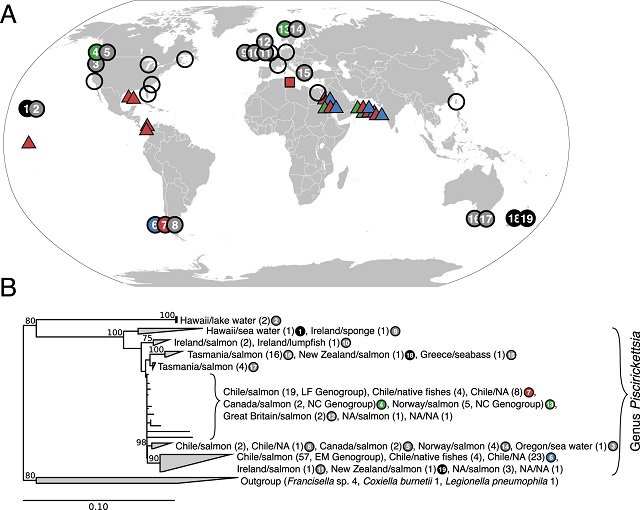
The global salmon industry is consistently confronted with the formidable challenge of managing pathogenic bacteria. Among them, Piscirickettsia salmonis, a marine gammaproteobacterium, stands out as the etiological agent of piscirickettsiosis, a disease wreaking havoc on various salmon species.
P. salmonis was first described 30 years ago during a severe outbreak in farmed Coho salmon (Oncorhynchus kisutch) in southern Chile. Since then, the disease has been reported in salmon farms in Norway, Scotland, Ireland, and Canada.
This pathogen is responsible for multi-systemic infections that result in significant mortality rates and substantial commercial losses in the aquaculture industry.
A new study published by scientists from the Leibniz Institute DSMZ-German Collection of Microorganisms and Cell Cultures, the Pontifical Catholic University of Valparaíso, and the University Austral of Chile delves into the global diversity, evolution, and selection of P. salmonis in the context of human interventions. The comprehensive analysis, using 73 high-quality, closed genome sequences, uncovers crucial information about the dynamics of this pathogen, offering valuable data to enhance its surveillance and strengthen the sustainability of salmon farming.
Understanding P. salmonis Diversity and Evolution
The study examined a variety of Piscirickettsia salmonis strains, including those involved in major outbreaks. To provide a holistic perspective, we also conducted an analysis of all available P. salmonis 16S rRNA gene sequences and metagenomic reads in public databases.
The genome comparison brought to light a surprising revelation: Piscirickettsia is not a monolithic entity but comprises at least three genetically isolated species. What’s even more intriguing is that two of these species show signs of ongoing speciation, indicating that an evolutionary journey is unfolding within this pathogen.
The process of Piscirickettsia diversification is marked by an extraordinary proliferation and diversity of transposases, which play a fundamental role in subgroups undergoing rapid speciation. These transposases are crucial in the acquisition of new genes and pseudogenization, contributing to the pathogen’s adaptive capacity.
In particular, scientists have identified several group-specific genes related to surface antigen synthesis, which may explain variations in virulence between strains. However, it’s important to note that the frequent failure of antibiotic treatments in piscirickettsiosis outbreaks is not predominantly attributed to the horizontal acquisition of resistance genes, which has occurred infrequently.
“As shown in our study, antibiotic resistance in Piscirickettsia is largely intrinsic, clearly absent in the case of florfenicol and oxytetracycline, and generally does not involve the horizontal acquisition of antibiotic resistance genes observed in other gammaproteobacteria, which also raises concerns for human health,” the researchers emphasize.
Implications for Salmon Farming Management
This dynamic diversification of Piscirickettsia salmonis has far-reaching implications for aquaculture management. It provides essential data to improve pathogen surveillance, enable the prediction of new lineages, and guide aquaculture practices. As we gain a deeper understanding of the genetic makeup and evolutionary trajectory of this pathogen, we can adapt our strategies to ensure the sustainability of the salmon farming industry.
“We detected genomic fragments of Piscirickettsia in datasets from various coastal and open sea environments. To date, the main environmental reservoirs of this important fish pathogen have not been identified. In this regard, sensitive detection methods targeting specific group-specific genes would also allow a systematic analysis of environmental samples and could help design and operate salmon farms in suitable locations, thereby enhancing their sustainability,” the researchers highlight.
By staying ahead in monitoring and responding to the evolving P. salmonis landscape, salmon farmers can mitigate the impact of piscirickettsiosis and continue to meet the growing demand for salmon products. In doing so, the salmon industry takes a significant step not only in managing this critical pathogen but also in securing the future of sustainable salmon production.
Conclusion
In conclusion, the study of Piscirickettsia salmonis offers a window into the complex world of pathogen management in aquaculture. Its genetic diversity and dynamic evolution underscore the need for continuous research, proactive surveillance, and adaptation strategies to ensure the longevity and resilience of the aquaculture industry.
Contact
Jörg Overmann
Leibniz Institute DSMZ-German Collection of Microorganisms and Cell Cultures, Braunschweig, Germany
Email: joerg.overmann@dsmz.de
Reference (open access)
Schober, I., Bunk, B., Carril, G. et al. Ongoing diversification of the global fish pathogen Piscirickettsia salmonis through genetic isolation and transposition bursts. ISME J (2023). https://doi.org/10.1038/s41396-023-01531-9

